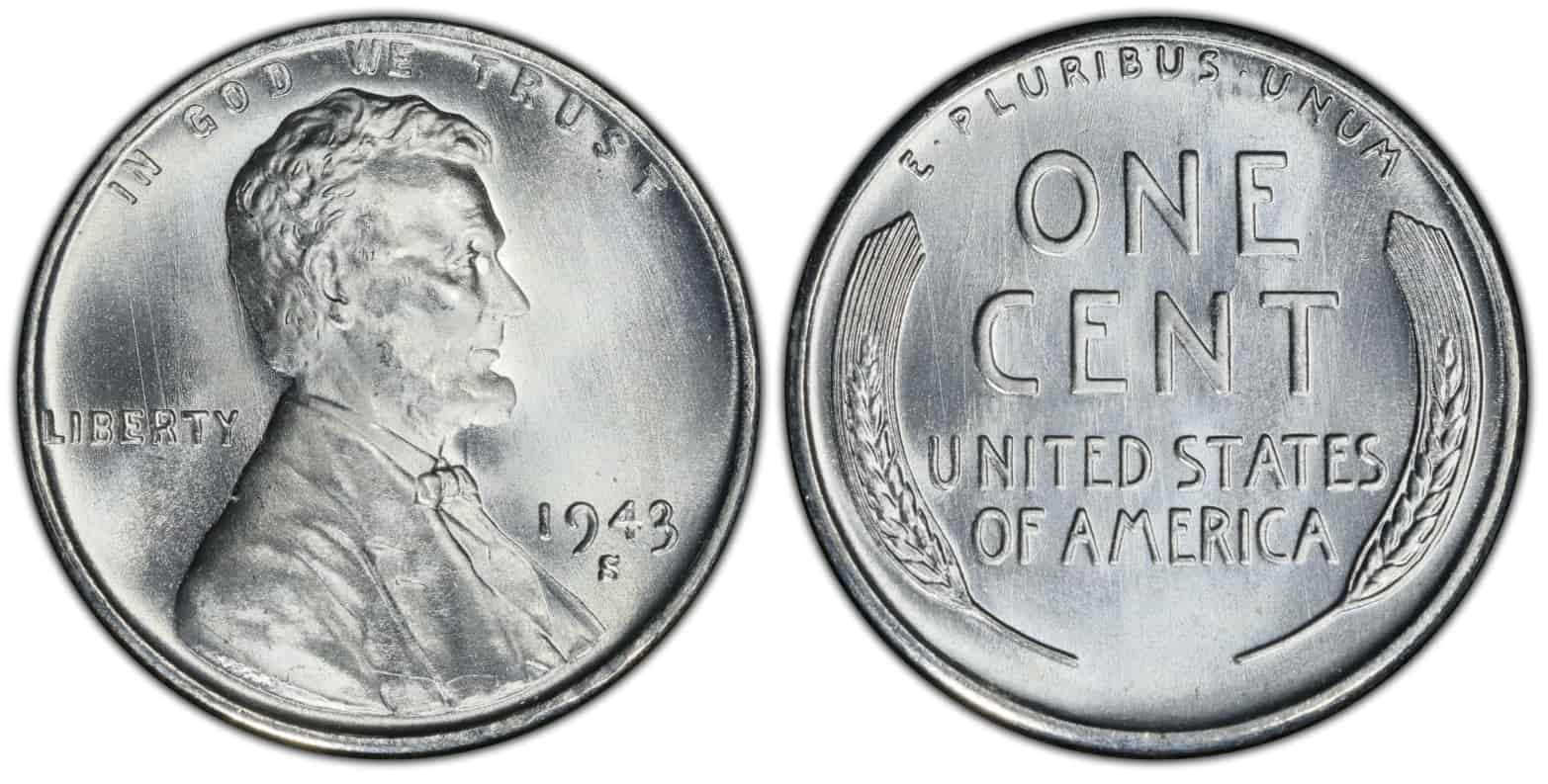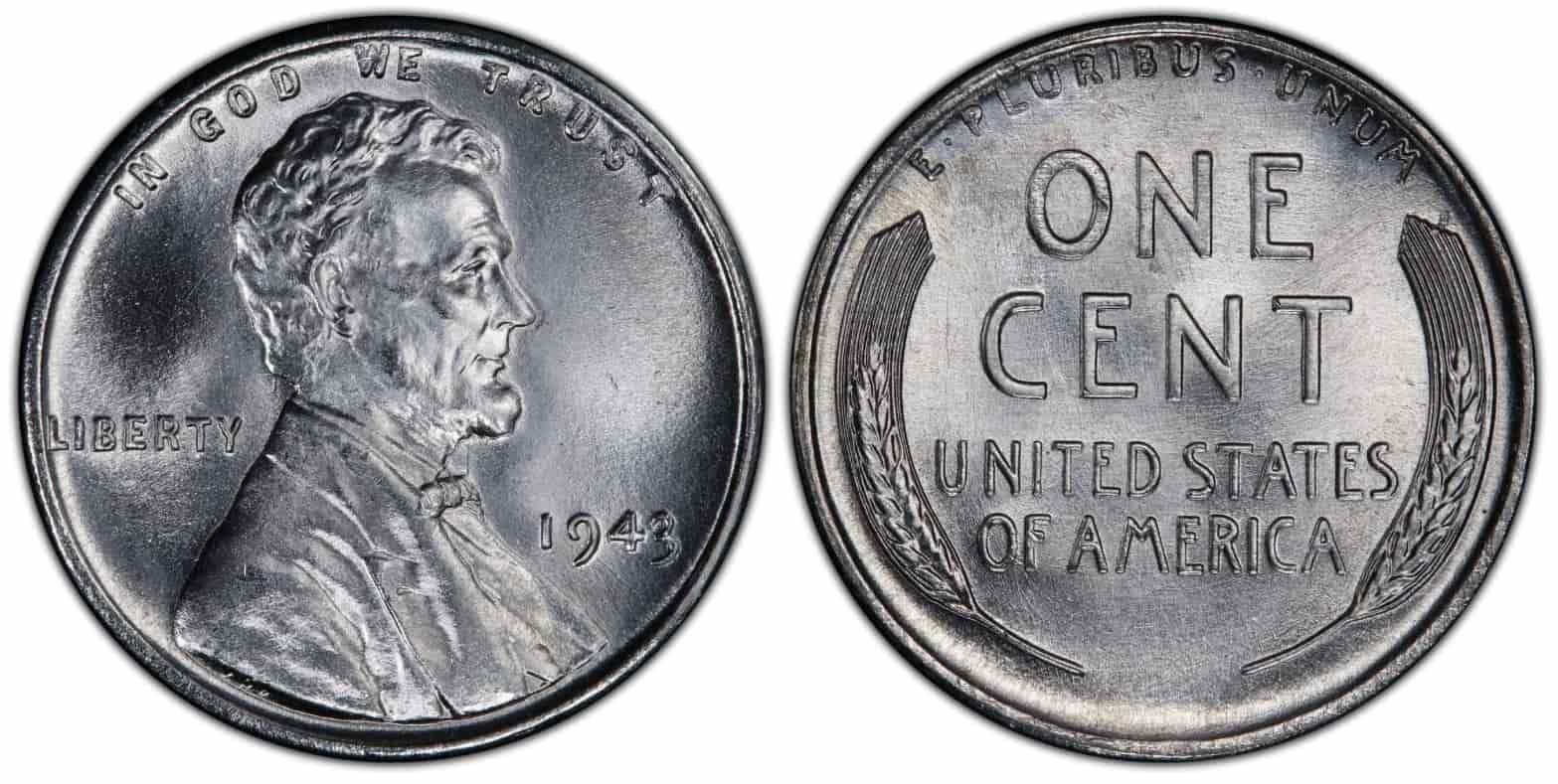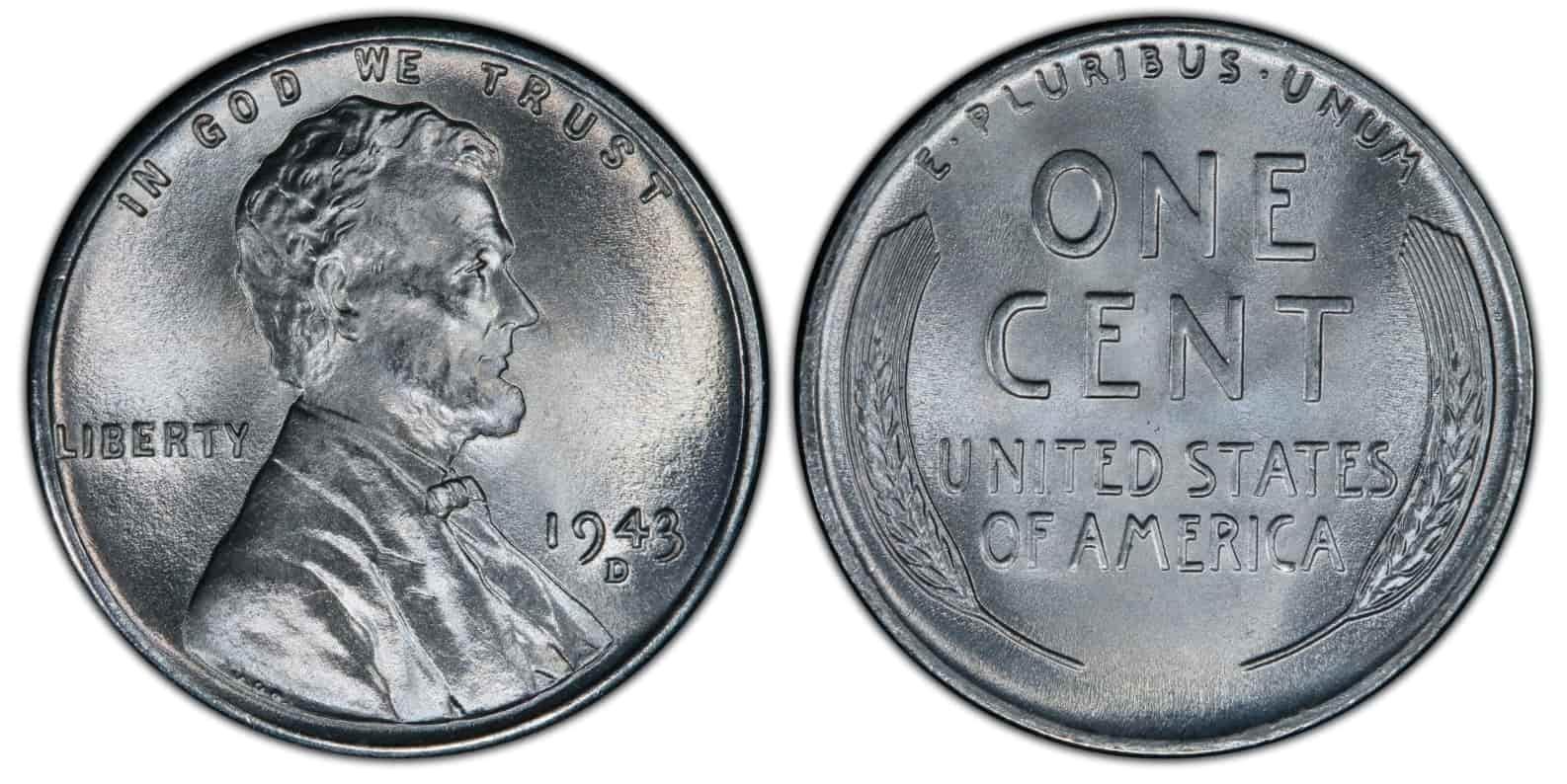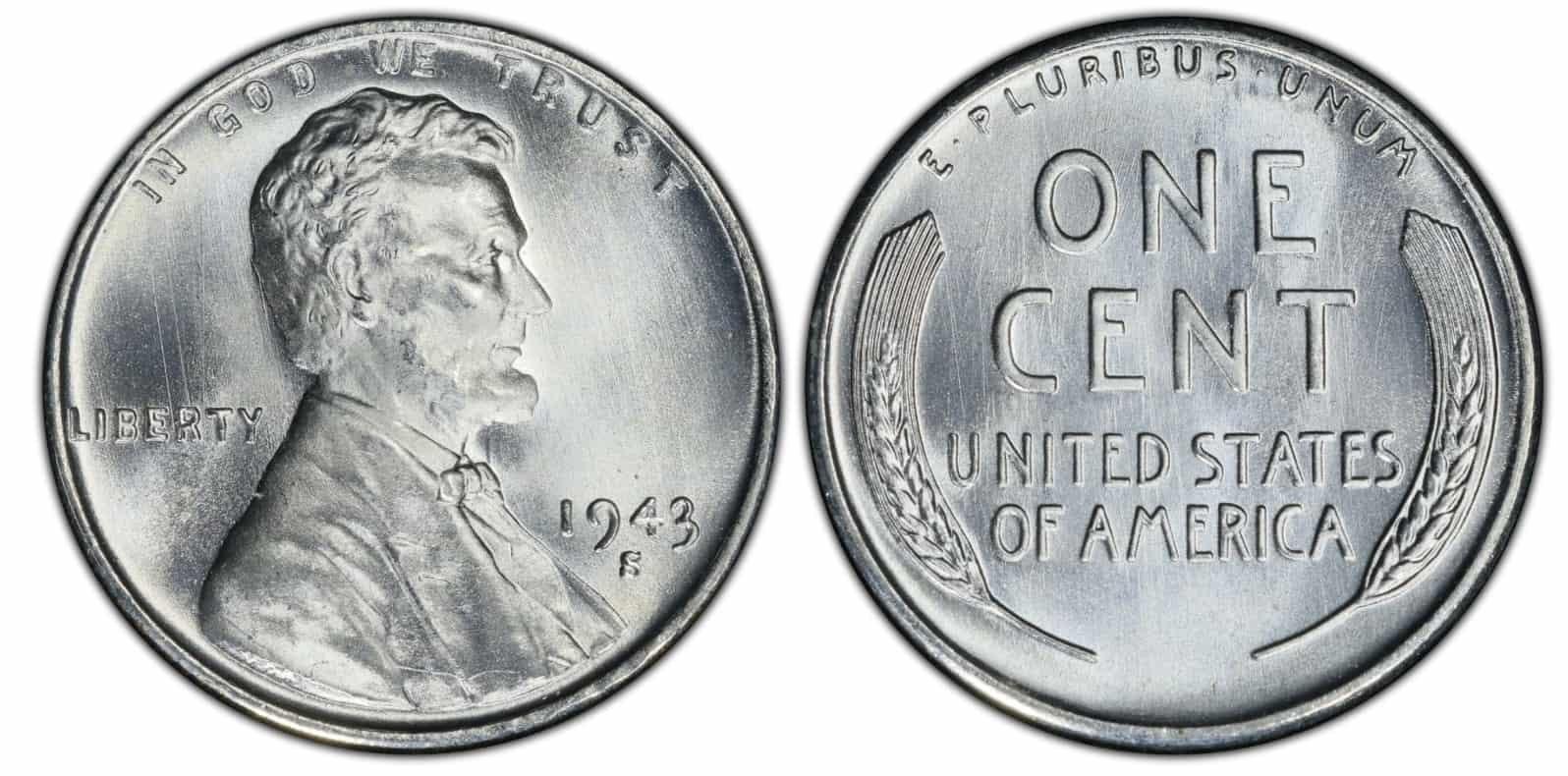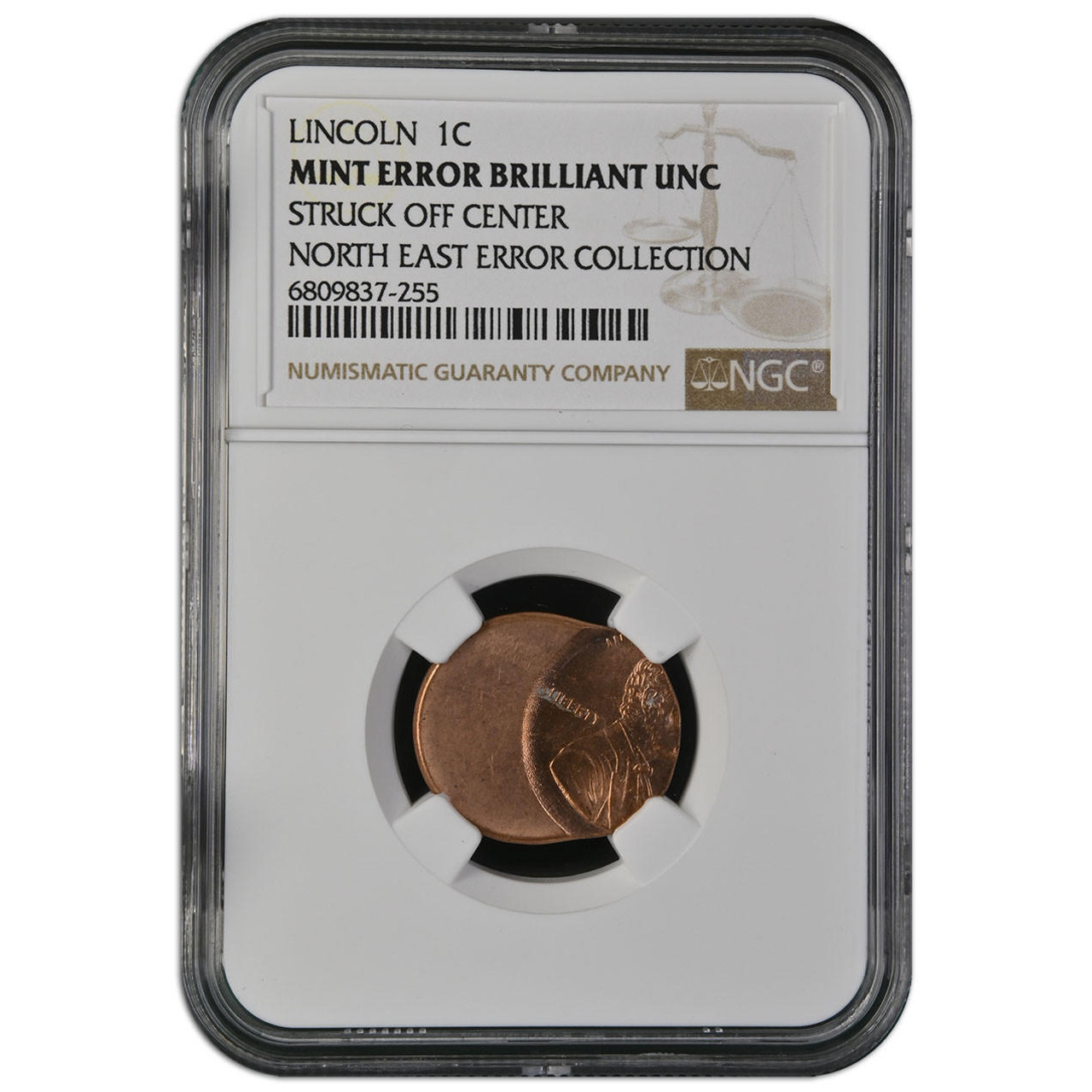1943 Steel Penny Value: How Much Is a 1943 Steel Penny Worth?
Posted by Andrew Adamo - A certified ANA Professional Numismatist, Active member of ICTA, contributor to CoinWeek, Numismatic News, NGC and ANA on May 28th 2025
1943 Steel Penny Value (Worth Up to $35,000+)
A circulated 1943 steel penny is worth 15 ¢-50 ¢, while uncirculated pieces start around $2. PCGS-certified gems reach $30-$575, and top-pop specimens or dramatic errors such as the 1943-D/D RPM can realise $12,000+. The record price, set at Heritage in 2010, is $218,500 for an AU-58 example.(PCGS). Continue reading to learn more about 1943 steel penny value.
Curious to know “how much is a 1943 steel penny worth now”? The value of a 1943 steel penny, as of 2025, typically ranges from 20 cents to $20, depending on its condition and mint mark. Rare error coins, like the 1943-D steel penny with a doubled mintmark, can be worth several hundred dollars. The highest auction price for a 1943 steel penny was $218,500. Read this article to learn about the rare 1943 steel penny value with Bullion Shark Rare Coin Dealer! And always check your 1943 steel pennies for unique features or errors that can fetch prices upwards of $500.
We update our website on a regular basis to ensure the most reliable information on the 1943 steel penny value, other rare coin values and coin collecting in general.
What Are Steel Pennies?
Steel pennies are Lincoln Wheat cents made in 1943. In 1943, the U.S. Mint produced Lincoln Wheat cents using steel, a deviation from the usual copper, to support the war effort in World War II by conserving copper. By 1944, the mint resumed using the standard copper composition for pennies.
There are few vintage coins as widely collected as the 1943 steel Lincoln penny. The 1943 steel Lincoln penny is exceptionally popular among collectors, both within the numismatic community and beyond. This coin, unique in its appearance among U.S. one-cent coins, stands out due to its zinc-coated steel composition, making it look more like a dime than a typical penny.
How to Tell Steel vs. Rare Copper (magnet & 3-gram test)
1943 Steel Penny Value - Latest Auction Records
Below are the exact price-guide numbers now showing inside PCGS for each mintmark, from worn grades all the way to trophy “registry” coins. I’ve kept the ladder compact—just the grades collectors actually quote in ads or auction descriptions—and pulled the single most recent auction record so you can reality-check the guide.
1943 (Philadelphia – no mint mark) PCGS
| Grade | PCGS Price | Comment |
|---|---|---|
| VF-20 | $1 | Bulk-roll value; nice gray surfaces command a small premium. |
| EF-40 | $1 | Still $1 in the guide—market trades closer to 25-50 ¢. |
| AU-58 | $7 | Cheapest path into “uncirculated” slabs. |
| MS-60 | $12 | Entry-level Mint State. |
| MS-63 | $16 | Typical eBay BU roll quality. |
| MS-65 | $24 | Widely available; pop ≈ 13,000. |
| MS-67 | $85 | First real set-registry spread. |
| MS-68 | $575 | Just 475 coins on the pop-report. |
| MS-69 | $5,500 | 13 certified; last public sale $4,440 (Jan 2024, Heritage). |
| MS-70 | $35,000 | Only one is graded 70; none sold publicly yet. |
| Auction record | $218,500 (AU-58) — Heritage, Jan 2010 |
AUCTION RECORD: $218,500 • AU58 • 01-06-2010
1943-D (Denver) PCGS
| Grade | PCGS Price | Comment |
|---|---|---|
| VF-20 | $1 | |
| AU-58 | $11 | |
| MS-60 | $12 | |
| MS-63 | $16 | |
| MS-65 | $24 | |
| MS-67 | $90 | |
| MS-68 | $185 | |
| MS-69 | $525 | |
| MS-70 | $16,500 (population = 2) | |
| Record | $14,400 (MS-68+) — Heritage, Jan 2025 |
RPM FS-501 (D/D): guide $400 in MS-64, moving to $19,500 in MS-68. Only 3,000–5,000 pieces exist overall.
1943-S (San Francisco) PCGS
| Grade | PCGS Price | Comment |
|---|---|---|
| VF-20 | $1 | |
| AU-58 | $11 | |
| MS-60 | $12 | |
| MS-63 | $16 | |
| MS-65 | $24 | |
| MS-67 | $100 (pop ≈ 6,900) | |
| MS-68 | $625 | |
| MS-69 | $4,000 | |
| MS-70 | $27,500 (population = 1) | |
| Record | $8,225 (MS-68+) — Legend, May 2023 |
Take - aways:
-
$1 ≠ street price — PCGS uses $1 as a placeholder for any grade that usually sells under a dollar; most raw VF-XF coins trade for 15–50 ¢.
-
Grade 67 is the pricing pivot. Values double (or better) once you clear MS-66 for any mint.
-
Registry “super-grades” (MS-68 and up) are where the big dollars—and the volatility—sit. Spreads between MS-68 and MS-69 jump 3–10×.
-
Error premiums: A doubled-die obverse or off-center strike adds $50-$500 to the numbers above; a bronze-planchet error drops into six-figure territory.
-
Population matters: Philadelphia MS-68 population is 475 vs. Denver’s 260 and San-Francisco’s 110, explaining the wider price spread at the top end.
How to Tell a Common Steel “Steelie” From the Ultra-Rare Copper 1943 Penny
Below is the copy you can paste under the H2 “How to Tell Steel vs. Rare Copper (magnet & 3-gram test)”. It gives readers a fast yes/no flow-chart plus the deeper EEAT detail Google loves.
Quick 2-Step Flow-Chart
-
Magnet Test (3 seconds)
Touch a neodymium magnet to the coin.-
Sticks? → 99.9 % chance it’s the ordinary steel cent.
-
Doesn’t stick? → Go to Step 2—weight test.
Why: Steel cents are low-carbon steel plated with zinc and are always magnetic; the rare copper errors contain no iron and never respond. NGC Coin Forum
-
-
Weight Test (10 seconds)
Place the coin on a 0.01 g digital scale.-
≈ 2.70 g ± 0.03 g → Standard 1943 steel cent. NGC Coin Forum
-
≈ 3.11 g ± 0.12 g → You may have a bronze/copper planchet error worth six figures—seek professional grading immediately. PCGS
-
Tip: Weigh inside a plastic flip so oils don’t corrode the zinc coating; subtract 0.20 g for the flip’s weight.
Why Color Alone Fails
-
Steel cents were originally silvery-gray, but millions were later copper-plated or “reprocessed” by dealers to look shiny. These still stick to a magnet and weigh ~2.7 g—don’t be fooled. Numismatic Guaranty Company
-
Conversely, genuine copper errors often tone chocolate-brown after 80 years, resembling any circulated Wheat cent.
Detailed Specs to Quote
| Spec | Steel Cent | Copper Error |
|---|---|---|
| Composition | Low-carbon steel core, thin zinc coat | 95 % copper, 5 % tin & zinc |
| Magnetic? | Yes (strong) | No |
| Target weight | 2.70 g | 3.11 g |
| Diameter | 19.05 mm (same) | 19.05 mm (same) |
| Auction record | $218,500 (AU-58, 2010) | $1.7 million (MS-63BN, 2010) |
Recommended Tools
-
Neodymium magnet – fridge magnets are too weak.
-
0.01 g USB-rechargeable digital scale – ~$15 online.
-
Soft nitrile gloves, lint-free pad, LED loupe.
Still Unsure?
If your coin passes the magnet test and weighs ~3.1 g, stop DIY testing—counterfeits exist. Submit to PCGS, NGC, or ANACS, or let Bullion Shark pre-screen it for you (free, insured shipping both ways).
Add those two simple tests and a caution about reprocessed pieces, and you’ve fully answered the most-asked question on every steel-penny forum—exactly what Google looks for when it surfaces featured snippets.
How Much Is a 1943 Steel Penny Worth in 2025?
As of January 2025, the value of a 1943 steel penny varies based on its condition and any unique characteristics. In average circulated condition, these pennies are typically valued between 20 cents to a $1. Uncirculated coins with original zinc coating can command higher prices, ranging from $1 to $5. Notably, a 1943 steel penny graded at MS60 is valued at approximately $11, with values increasing significantly for higher grades. For example, a coin graded MS65 is valued at around $30, and those graded MS68 can reach up to $5,250. Additionally, a 1943-D Lincoln bronze cent, one of the few known 1943 copper alloy pennies, was sold on Coin Auctions for $504,000 in January 2019.
- 1943 Steel Penny (Philadelphia Mint) – Minted during WWII under Franklin D. Roosevelt's presidency.
- 1943-D Steel Penny (Denver Mint) – Produced during the wartime metal conservation efforts initiated by Roosevelt's administration.
- 1943-S Steel Penny (San Francisco Mint) – Made under the direction of U.S. Treasury Secretary Henry Morgenthau Jr. during World War II.
- 1943 Copper Penny (Philadelphia Mint) – Value: $100,000 to $1,700,000 (depending on condition) – A rare error coin from the Roosevelt era, stemming from wartime copper shortages.
- 1943-D Double Mintmark Steel Penny – Value: $20 to $50 (depending on condition) – This error coin was minted during the WWII period, overseen by Treasury Secretary Morgenthau Jr.
How Much Is a 1943 Steel Penny Worth in 2025? 1943 Steel Penny Value:
Most 1943 steel Lincoln pennies aren’t worth much above their face value (one cent).
This misconception about their worth might be attributed to the fame of the much rarer 1943 bronze cents. These bronze cents are notable off-metal transitional errors, accidentally produced when a few remaining 1942 copper planchets were mistakenly used in the coin presses at the Philadelphia, Denver, and San Francisco Mints. This rarity has contributed to a general but incorrect assumption about the value of all 1943 pennies.
The 1943 Steel Penny value depends on its condition and whether it has any rare errors. Here’s a breakdown of its worth:
- Circulated Condition: Most 1943 Steel Pennies found in circulation are worth 10 to 50 cents.
- Uncirculated Condition: A well-preserved 1943 Steel Penny can be worth $2 to $10, with higher-grade examples fetching $20 or more.
- Certified High-Grade (MS-65 or higher): PCGS or NGC-graded examples in top condition can sell for $100 or more, with some premium specimens reaching several hundred dollars.
- Rare Errors:
- 1943 Copper Penny: If your 1943 penny is made of copper instead of steel, it is extremely rare and worth $100,000+, with some sales exceeding $1 million.
- 1943 Steel Penny with a Doubled Die: Some rare doubled-die errors can be worth $50 to $500.
- 1943 Steel Penny with an Off-Center Strike: Depending on how off-center the strike is, values can range from $10 to several hundred dollars.
To determine the exact value of your 1943 Steel Penny, consider its grade, mint mark (P, D, or S), and whether it has any unique errors. Professional grading can help confirm its authenticity and worth.
The 1943 copper penny is extremely rare and valuable. Only a couple dozen pieces were made and exist today, and each is worth about $100,000.
The key difference between the rare 1943 copper cents and the more common steel cents is discernible through weight and magnetic properties. The copper cents, weighing approximately 3.11 grams, do not react to a magnet. In contrast, the steel cents, lighter at 2.7 grams, will stick to a magnet. Over the years, the combination of a magnet and a gram scale has been a tool for reality checks, often dispelling illusions and shattering hopes regarding the rarity and value of 1943 Lincoln cents.The record price for a 1943 copper Lincoln penny is over $1.7 million at auction in 2010.
The 1943 steel cents are quite common, with over 1 billion produced for circulation. The production figures for each mint are as follows:
- 1943 Philadelphia Mint cents – 684,628,670
- 1943-D Denver Mint cents – 217,660,000
- 1943-S San Francisco cents – 191,550,000
Although a significant number of 1943 steel cents have deteriorated due to corrosion or have been lost over time, millions of these pennies still exist and are collectible. As a result, they are relatively common and typically hold little value for collectors, especially in circulated conditions.
Generally, 1943 Lincoln pennies in average, worn conditions are valued at approximately 10 to 25 cents each. Those in uncirculated condition typically fetch between $1 and $5. However, the value significantly increases for top-level specimens, particularly those graded at Mint State-67 or higher, which can command prices ranging from hundreds to even thousands of dollars.
1943 Steel Penny Error Value
The most expensive 1943 steel penny ever sold is an error coin: a 1943 Lincoln penny that was mistakenly struck on a bronze planchet rather than the zinc-coated steel planchet used that year due to wartime metal conservation efforts. This type of error is extremely rare and highly prized among collectors.
The most famous and valuable example of this error was sold at auction:
- In January 2019, a 1943-D Lincoln bronze cent, one of the few known 1943 copper alloy pennies, was sold by Heritage Auctions for $504,000. This coin was graded by PCGS as MS64BN.
Other significant sales of 1943 copper pennies include:
- A 1943-S bronze Lincoln cent sold in August 2007 for $1 million to a collector. This sale was a private transaction rather than an auction.
- Another 1943 copper penny from the Philadelphia mint was sold by Legend Numismatics of Lincroft, New Jersey, for $1.7 million in September 2010. This coin was also part of a private sale.
These prices reflect the rarity and exceptional collector demand for these error coins. Only a handful of 1943 bronze cents are known to exist, making any such example highly valuable.
How Rare Is the 1943 Steel Penny? 1943 Steel Penny Value
Among the 1943 steel cents, notable varieties include the 1943-D/D repunched mintmark. This sought-after variety commands a higher value, with prices exceeding $100 in Extremely Fine-40 grade and going upwards of $400 in Mint State-63. Although there is no specific mintage figure for the 1943-D/D Lincoln cent, it is estimated that possibly only 3,000 to 5,000 examples exist in all grades.
Non-error steel cents are not inherently rare; their appeal largely lies in their novelty. The value of a steel penny is heavily dependent on the coin's condition.
Why 1943 Pennies Were Struck in Steel
The 1943 steel penny's unique zinc-coated steel composition gives it a resemblance closer to a dime than a conventional U.S. penny. The reasons behind the production of these unusual coins, their current market value, and the methods for collectors to acquire 1943 steel cents are intriguing aspects to explore.
The steel penny may seem like a random anomaly, but it is deeply linked to a significant global event. The 1943 steel cent was produced during the peak of World War II, a period when the U.S. military was actively involved from 1941 to 1945.
During this global conflict, the Allied Forces required numerous critical resources for their war efforts. Among these were copper and nickel, which were crucial for manufacturing ammunition and artillery.
However, these metals were also key components in coin production, which traditionally consisted mostly of copper and nickel.
Therefore, the Lincoln cent and Jefferson nickel became prime targets for temporary but necessary alterations. An act of Congress in 1942 approved a provisional 35% silver composition for the nickel. This paved the way for an emergency composition for the one-cent coin as well.
Following a series of experiments and trials for an emergency substitute, various materials including plastic and glass were considered. Ultimately, the most economical alternative for the Lincoln penny was identified as a planchet composed of 99% steel, coated with a thin layer of zinc. This choice of zinc-coated steel planchets offered an effective and cost-efficient solution for producing the 1943 pennies, thereby allowing copper to be conserved for wartime needs. Despite this change in composition, the diameter of the coin at 19.05 mm and the iconic portrait of Abraham Lincoln remained unchanged.
Despite the practical reasons behind their creation, the public's reception of the steel cents was less than enthusiastic. Common complaints arose due to their similarity to dimes, leading to frequent mix-ups that could result in a loss of 9 cents (or more) during transactions. Additionally, the coins faced criticism for their propensity to rust quickly once the protective zinc coating wore away, exposing the underlying steel core.
Responding to public dissatisfaction, the United States Mint reverted to a copper-based composition for the Lincoln cent in 1944, after only a year of producing the steel cents. This return to copper was made possible by repurposing copper shell casings collected from military training facilities. The pennies minted from these materials, known as shell case cents and produced through 1946, featured a composition of 95% copper and 5% zinc. This composition was slightly different from the usual formulation for Wheat pennies at the time, which typically consisted of 95% copper, combined with 5% tin and zinc.
Collecting the 1943 Lincoln Penny
Numerous coin collectors add the different 1943 pennies into their broader collections of Lincoln cents. However, the set of business-strike 1943 Lincoln steel cents from the Philadelphia, Denver, and San Francisco mints form a highly sought-after one-year short set. These sets, often found in mass-market distributions, typically contain "reprocessed" pennies — coins that have been stripped and recoated. They are frequently assembled in plastic display cases and marketed through advertisements in newspapers and general-readership magazines.
FAQ
How Much Is a 1943 Steel Penny Worth?
The 1943 Steel Penny value depends on its condition, mint mark, and any rare errors. Most circulated examples are worth between 10 and 50 cents, while uncirculated coins can fetch $2 to $10, with high-grade certified pieces reaching $100 or more. Rare error varieties, such as the highly sought-after 1943 Copper Penny, can be worth over $100,000, and some have sold for more than $1 million. Other errors, like doubled dies or off-center strikes, can also increase the value significantly. Checking for key details and getting professional grading can help determine the true worth of a 1943 Steel Penny.
How can I spot a fake 1943 steel penny?
To spot a fake 1943 steel penny, check the weight and sound. Authentic 1943 steel pennies weigh around 2.7 grams. If the coin feels too light or heavy, it may be a counterfeit. Use a magnet as well—genuine 1943 steel pennies are magnetic because they are made from steel. If the coin does not stick to a magnet, it may not be authentic. Additionally, inspect the coin for any signs of unusual wear or poorly defined details, which could indicate a fake.
What are the most common error types found on 1943 steel pennies?
The most common errors on 1943 steel pennies include double mintmarks, die cracks, and off-center strikes. The 1943-D double mintmark is a highly sought-after error, where the mintmark appears twice, creating a unique and valuable coin. Other notable errors are the 1943 copper penny, a rare coin produced by mistake, which can fetch hundreds of thousands of dollars at auction.
How can I verify if a 1943 steel penny is an error coin?
To verify if a 1943 steel penny is an error coin, closely examine the coin for unusual features such as doubled mintmarks, misaligned dies, or off-center strikes. If you suspect a rare 1943 copper penny (which was accidentally struck in copper), look for the distinctive reddish hue and weigh the coin—genuine copper pennies weigh 3.11 grams, whereas the steel version weighs 2.7 grams. For a more accurate assessment, have the coin professionally graded by a numismatic service.
What is the value of a 1943 steel penny in poor condition?
Even in poor condition, a 1943 steel penny retains some value due to its historical significance. Typically, a heavily worn 1943 steel penny will be worth around 10 to 25 cents. However, the condition of the coin greatly affects its value, and coins with more visible details or minimal wear will fetch a higher price. Collectors are always on the lookout for coins in better condition, even if they are not mint-grade.
What makes the 1943 steel penny so collectible?
The 1943 steel penny is collectible due to its unique historical background. During World War II, the U.S. government switched from using copper to steel for penny production to conserve copper for wartime needs. The 1943 steel penny represents a significant moment in U.S. history, which makes it an appealing item for collectors. The coin's rarity, especially in higher grades or with errors, and its association with the war effort, make it highly collectible.
Why was the 1943 penny made of steel?
The 1943 penny was made of steel because copper was needed for wartime materials during World War II. The U.S. Mint used zinc-coated steel to conserve copper for war essentials like shell casings and wiring.
Are 1943 steel pennies rare?
No, 1943 steel pennies are not considered rare as over a billion were minted. However, they are popular among collectors due to their unique composition and historical context.
What are the key factors that affect the value of a 1943 steel penny?
Condition, preservation of the zinc coating, and the presence of any errors or varieties (like the double die) significantly affect the value. Uncirculated coins with original luster are valued higher.
What is the most valuable 1943 steel penny?
The most valuable 1943 steel pennies are those struck in error on bronze planchets left over from 1942. These extremely rare coins can sell for over $100,000 depending on their condition.
How can I tell if my 1943 steel penny is valuable?
Check for a well-preserved zinc coating, lack of rust or corrosion, and overall condition. Consider having it appraised by a professional, especially if it shows unusual characteristics like being struck on a copper planchet.
Can a 1943 steel penny stick to a magnet?
Yes, a genuine 1943 steel penny will stick to a magnet due to its steel core.
What is the error version of the 1943 steel penny?
The most notable error for the 1943 steel penny is the aforementioned few mistakenly struck on copper-alloy planchets. These are highly prized and extremely valuable.
Where can I sell my 1943 steel penny?
You can sell your 1943 steel penny through coin dealers, online marketplaces, auctions, or coin collecting forums. For high-value errors, consider a reputable auction house.
How should I store my 1943 steel penny?
Store it in a dry environment in appropriate coin storage materials like flips, holders, or albums designed for coin preservation to prevent corrosion and maintain its condition.
Collecting 1943 steel pennies can be an enjoyable and accessible entry into the world of coin collecting, offering both historical appeal and the fun of hunting for the rare error varieties.
Learn more about 1936 buffalo nickel value, rare state quarters, rare pennies worth money list, Susan b Anthony coins, how many nickels in a roll, 1953 wheat penny value, quarters worth money, pennies worth money, 1942 penny value, what are nickels made of, most valuable quarters, 1945 wheat penny value, Morgan silver dollars, silver American eagles, Franklin half dollars, 1944 wheat penny value, silver certificate.



